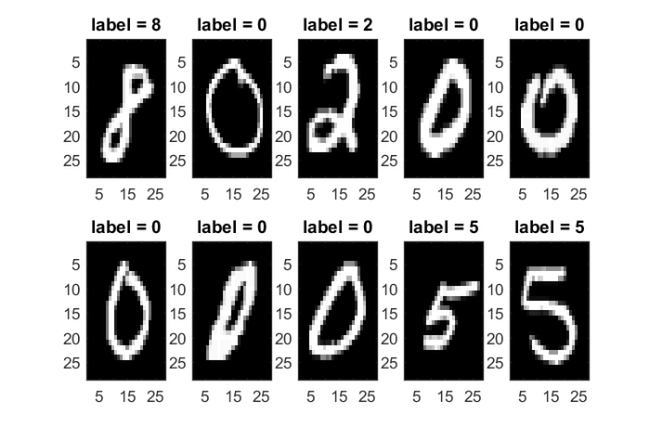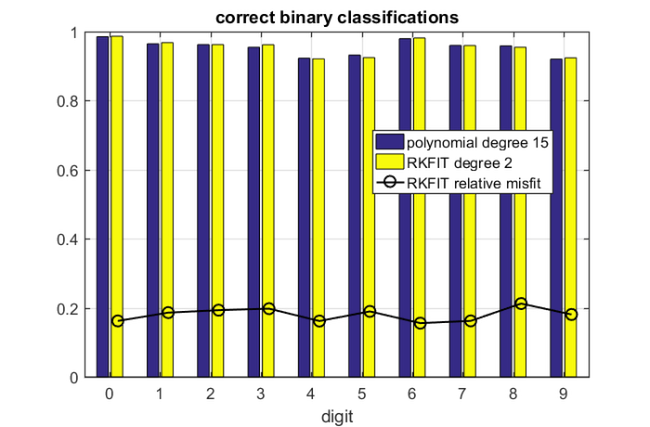Graph label propagation via RKFIT
Stefan Güttel, July 2020Download PDF or m-file
Contents
Introduction
Label propagation refers to the problem of diffusing node labels on a graph using its connectivity information. If two nodes are connected by an edge, they are considered to be more likely to share the same label. Label propagation can be used to automatically label graph nodes after only a subset of nodes has been labeled manually.
Here we consider an example from [2], where a similarity graph of images in the popular MNIST collection is constructed using a nearest neighbor search. Each image in that collection depicts a hand-written digit among  . A fraction of these images is prelabeled and the aim then is to construct ten one-against-all classifiers to recognize the other digits.
. A fraction of these images is prelabeled and the aim then is to construct ten one-against-all classifiers to recognize the other digits.
In [2], the classifiers are constructed using degree-15 polynomials of the adjacency matrix (in that paper, the degree is referred to as the number of 'taps'  ). Our aim is to demonstrate that RKFIT [1] is able to significantly compress these polynomial filters into lower-degree rational functions without sacrificing the classification performance.
). Our aim is to demonstrate that RKFIT [1] is able to significantly compress these polynomial filters into lower-degree rational functions without sacrificing the classification performance.
Data loading
We start by loading the MNIST data set. This is available at several locations on the internet and we have used http://yann.lecun.com/exdb/mnist/, retaining the 60,000 training images with their respective labels for this experiment.
if exist('mnist.mat') ~= 2 disp('File mnist.mat not found. Data can be downloaded from:') disp('http://yann.lecun.com/exdb/mnist/') return end load mnist images = training.images; labels = training.labels;
In order to shorten the runtime for this experiment, we will choose a small random subset of keep images, and assume that n_known of these images have known labels. The polynomial classifier is then trained on an even smaller number of n_train images.
keep = 1000; % total number of images to work with n_known = 150; % number of images with known labels n_train = round(n_known/3); % training set ind = sort(randperm(length(labels),keep)); images = images(:,:,ind); labels = labels(ind);
Below we visualize the first few of the selected images with their labels.
figure for i = 1:2 for j = 1:5 ind = (i-1)*5+j; subplot(2,5,ind) imagesc(images(:,:,ind)) title(['label = ' num2str(labels(ind))]) hold on end end colormap gray; shg

Nearest neighbor adjacency
Now we construct the nearest neighbor graph having a number of keep nodes, one for each image, by connecting nodes (=images) by edges when their Frobenius norm distance is relatively small.
k = 7; AA = sparse(keep,keep); for i = 1:keep Dif = repmat(images(:,:,i),1,1,keep) - images; for j = 1:keep dif(j) = norm(Dif(:,:,j),'fro'); end [~,ind] = sort(dif); ind = ind(2:1+k); AA(i,ind) = 1; end A = AA' + AA; % symmetric adjacency matrix
Training the classifiers
We now follow the approach in [2] and construct, for each digit  , a polynomial classifier of degree
, a polynomial classifier of degree  . These classifiers are obtained by solving least squares problems
. These classifiers are obtained by solving least squares problems
![$$
p^{[d]} = \mathrm{argmin}_{p\in\mathcal{P}_L} \| D^{[d]} p(A) \mathbf{t}^{[d]} - \mathbf{1} \|_2,
$$](example_digits_eq12760091143183327422.png)
where ![$D^{[d]}$](example_digits_eq02855140814159702608.png) is a diagonal matrix with diagonal entries
is a diagonal matrix with diagonal entries  (image does not depict digit
(image does not depict digit  ),
),  (image is not labeled), or
(image is not labeled), or  (image depicts digit
(image depicts digit  ). The vector
). The vector ![$\mathbf t^{[d]}$](example_digits_eq10832165205875921505.png) contains
contains  to represent the labels of the training data, and
to represent the labels of the training data, and  is the vector of all ones.
is the vector of all ones.
The ten polynomial classifiers are used to label all images that haven't been prelabeled simply by evaluating the polynomials as ![$p^{[d]}(A)\mathbf k^{[d]}$](example_digits_eq11175882781734559794.png) , where now
, where now ![$\mathbf k^{[d]}$](example_digits_eq09611477086358278638.png) is a vector representing the known image labels. In a similar manner, we can use RKFIT to reapproximate these degree
is a vector representing the known image labels. In a similar manner, we can use RKFIT to reapproximate these degree  polynomials with degree-2 rational functions,
polynomials with degree-2 rational functions, ![$r^{[d]}(A)\mathbf k^{[d]} \approx p^{[d]}(A)\mathbf k^{[d]}$](example_digits_eq04447166549388138423.png) , and then use these for the labeling instead.
, and then use these for the labeling instead.
The below code implements all that and measures the classification performance of both the polynomial classifiers and the compressed RKFIT classifiers. In order to obtain measurements of some statistical robustness, we run the randomized labeling and classification several times and then average. (Note that the code is not optimized for performance and we only display its text output for the first run.)
runs = 5; % training runs for averaging of performance Corr = []; Corr2 = []; Corrbin = []; Corrbin2 = []; Misfit = []; for run = 1:runs disp(['RUN NUMBER ' num2str(run) ]) known = sort(randperm(keep,n_known)); train = known(sort(randperm(n_known,n_train))); Digit = []; Digit2 = []; for digit = 0:9 lab = labels; lab(lab==digit) = -1; lab(lab~=-1) = 1; d = zeros(keep,1); d(known) = lab(known); D = spdiags(d,0,keep,keep); e = zeros(keep,1); e(train) = lab(train); E = spdiags(e,0,keep,keep); o = ones(keep,1); % construct classifier for training vector v = e; % training vector Basis = []; L = 15; % degree of polynomial (taps) for j = 0:L Basis = [ Basis , D*v ]; v = A*v; % Arnoldi procedure would be more stable! end h = pinv(Basis)*o; % get polynomial coeffs % apply classifier to vector of known labels Fd = 0*d; v = d; % known label vector M = eye(keep); F = 0*M; for j = 0:L Fd = Fd + h(j+1)*v; v = A*v; F = F + h(j+1)*M; M = A*M; end % degree-2 RKFIT recompression of the filter param = struct(); param.deflation_tol = 0; param.real = 1; param.maxit = 10; param.waitbar = 0; param.tol = 0; param.return = 'best'; [xi, ratfun, misfit, out] = rkfit(F, A, e, inf(1,2), param); Fd2 = ratfun(A,d); Misfit(run,digit+1) = min(misfit); % count number of correct binary classifications corrbin = sum((sign(Fd)==sign(lab)))/keep; Corrbin(run,digit+1) = corrbin; Digit = [ Digit , Fd ]; corrbin2 = sum((sign(Fd2)==sign(lab)))/keep; Corrbin2(run,digit+1) = corrbin2; Digit2 = [ Digit2 , Fd2 ]; if run == 1 disp([' Training a classifer for digit: ' num2str(digit)]) disp([' Correct POLY binary classifications: ' num2str(corrbin) ]) disp([' Correct RKFIT binary classifications: ' num2str(corrbin2) ]) end end % evaluate number of overall correct classifications [~,ind] = min(abs(Digit+1),[],2); ind = ind-1; corr = sum((ind==labels))/keep; Corr = [ Corr , corr ]; [~,ind] = min(abs(Digit2+1),[],2); ind = ind-1; corr2 = sum((ind==labels))/keep; Corr2 = [ Corr2 , corr2 ]; if run == 1 disp([' OVERALL POLY correct classifications: ' num2str(corr)]) disp([' OVERALL RKFIT correct classifications: ' num2str(corr2)]) else disp(' [output supressed]') end disp('--------------------------------------------------------------') end disp(['MEAN POLY correct digit classifications: ' num2str(mean(Corr))]) disp(['MEAN RKFIT correct digit classifications: ' num2str(mean(Corr2))])
RUN NUMBER 1
Training a classifer for digit: 0
Correct POLY binary classifications: 0.989
Correct RKFIT binary classifications: 0.988
Training a classifer for digit: 1
Correct POLY binary classifications: 0.973
Correct RKFIT binary classifications: 0.976
Training a classifer for digit: 2
Correct POLY binary classifications: 0.974
Correct RKFIT binary classifications: 0.974
Training a classifer for digit: 3
Correct POLY binary classifications: 0.972
Correct RKFIT binary classifications: 0.971
Training a classifer for digit: 4
Correct POLY binary classifications: 0.943
Correct RKFIT binary classifications: 0.945
Training a classifer for digit: 5
Correct POLY binary classifications: 0.936
Correct RKFIT binary classifications: 0.929
Training a classifer for digit: 6
Correct POLY binary classifications: 0.99
Correct RKFIT binary classifications: 0.99
Training a classifer for digit: 7
Correct POLY binary classifications: 0.948
Correct RKFIT binary classifications: 0.951
Training a classifer for digit: 8
Correct POLY binary classifications: 0.956
Correct RKFIT binary classifications: 0.954
Training a classifer for digit: 9
Correct POLY binary classifications: 0.922
Correct RKFIT binary classifications: 0.944
OVERALL POLY correct classifications: 0.797
OVERALL RKFIT correct classifications: 0.806
--------------------------------------------------------------
RUN NUMBER 2
[output supressed]
--------------------------------------------------------------
RUN NUMBER 3
[output supressed]
--------------------------------------------------------------
RUN NUMBER 4
[output supressed]
--------------------------------------------------------------
RUN NUMBER 5
[output supressed]
--------------------------------------------------------------
MEAN POLY correct digit classifications: 0.775
MEAN RKFIT correct digit classifications: 0.7822
Performance evaluation
The below bar chart shows the classification accuracy for each of the ten binary (one-against-all) polynomial classifiers, and their respective RKFIT compressions. In this example we have prelabeled 150 of the 1000 images and achieved a classification accuracy above 77 %. The accuracy will increase if we prelabel a larger fraction of the images. We generally find that a degree-2 rational approximant is just as good as the degree-15 polynomial one, and in some cases even slightly better. We do not know whether this is a random artefact or if there is an explanation why the rational reapproximation can increase ("extrapolate") the classification performance. This might be of interest for future research.
figure bar(0:9,[mean(Corrbin); mean(Corrbin2) ]') hold on, plot((0:9)+.16,mean(Misfit),'k-o') title('correct binary classifications') legend('polynomial degree 15','RKFIT degree 2',... 'RKFIT relative misfit','Location','Best') xlim([-.5,9.5]), ylim([.0,1]), grid on, xlabel('digit');

References
[1] M. Berljafa and S. Güttel. The RKFIT algorithm for nonlinear rational approximation, SIAM J. Sci. Comput., 39(5):A2049--A2071, 2017.
[2] A. Sandryhaila and J. M. F. Moura. Discrete signal processing on graphs: Graph filters, in 2013 IEEE International Conference on Acoustics, Speech and Signal Processing, pp. 6163--6166, 2013.